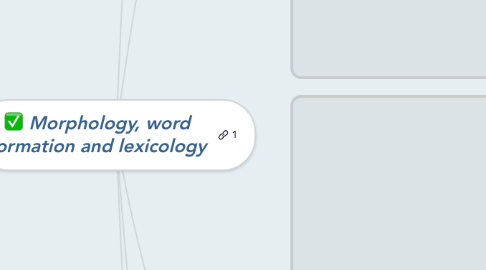
1. Morphology: is the study of the basic building blocks of meaning in language, morphemes.
1.1. Free morphemes or roots: can appear as a word by itself.
1.2. Bound morphemes or affixes: can only appear as part of a multi-morphemic word.
1.2.1. Derivational morphemes: create new words
1.2.2. Inflectional morphemes: make minor grammatical changes.
1.2.3. Prefixes
1.2.4. Suffixes
1.2.5. Infixes
1.3. Content morphemes: carry semantic content
1.4. Funtion morphemes: provide grammatical information and syntactic agreement
2. Pragmatics: is the study of how people do things with words.
2.1. Speech acts: use language to accomplish certain kinds of acts
2.1.1. Direct speech acts: 1) Assertion; 2) Question; 3) Orders and requests. Can include performative verbs.
2.1.2. Indirect Speech Acts: not referring to literal meaning.
2.2. Conversational implicature: the participants in a conversation are cooperating in an attempt to reach mutual goals. Include the maxims of quantity, quality, relevance and manner.
2.3. Rhetorical Structure: embrace the relationships of phrases inside sentences and among sentences or groups of sentences.
2.4. Managing the flow of reference in discourse to transmit the message.
3. Semantics: is the study of the relation between form and meaning.
3.1. The words meaning is given from the relations between words, concepts and things.
3.1.1. Referential theories of meaning: meaning is reference to facts or objects in the world, that is the denotation relation
3.1.2. Truth-conditional theory of semantics: to know the meaning of a declarative sentence is to know what the world would have to be like for the sentence to be true. To give the meaning of a sentence is to specify its truth conditions,
3.1.2.1. Intensional semantics refers to the Truth-conditional semantics that is enriched with possible worlds: 1) hypothetical conditional sentences; 2) counterfactual conditional sentences.
3.1.3. The model-theoretic semantics: refers to models or structures. The worlds that can be construed in terms of abstract mathematical entities are called model.s
3.1.4. Cognitive and conceptual semantic theories: are concerned with words that describe concepts that have no clear category boundaries and whose members do not have an equal status.
3.1.4.1. Fillmore: words and other linguistic units up to the sentence level are interpreted against the background of Frames. A frame is a structure of inferences, linked by linguistic convention to the meanings of linguistic unit.
